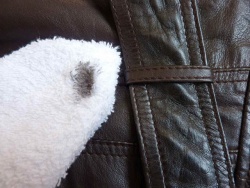Difference between revisions of "Leather defects"
From www.leather-dictionary.com - The Leather Dictionary
(Created page with "<p align=center> 300px </p> '''Lederfehler''' sind Mängel im fertigen Leder, die entweder bereits in Hautschäden|Schäden in der Rohh...") |
|||
| Line 4: | Line 4: | ||
| − | + | Leather defects are defects in the finished [[leather]], which are caused by damaged [[Natural markings on leather|raw skin]], or have arisen due to wrong [[Storage of leather|storage]] or are caused by improper processing during the [[Leather production|manufacturing process]]. | |
| − | * '''[[ | + | * '''[[Dye transfer from leather]]''' is a result of insufficient color fixation, for example by excessively concentrated dyes or too little washing out after dyeing. If the color concentration is too high, '''[[Bronzing leather|bronzing]]''' can occure. |
| − | * | + | * In the [[Liming - Leather Tanning|liming process]], too long remaining in fresh air can cause "liming stain"s on the [[Leather grain - Grain side|grain side]] of the leather. |
| − | * | + | * Irregularly blood spots are caused by lack of drainage of the salt liquor after the [[Preservation by drying, salting or freezing|preservation of the hides by salting]]. |
| + | |||
| + | * Colour defects can occur if the applied [[leather colour|colouration]] does not cover uniformly, especially on already damaged areas. | ||
| + | |||
| + | * '''[[Fatty spue - Fat marks on leather]]''' occurs with leathers containing a high level of fat such als [[sheep leather]]. | ||
| + | |||
| + | * '''Tannin stains''' is caused by uneven concentration of the [[Tannins|tanning agent]] in the [[leather production]. | ||
| − | |||
| − | |||
* '''Gerbstoffflecken''' entstehen dann, wenn es bei der [[Gerbung]] zu Ungleichverteilungen in der Konzentration des Gerbmittels kommt. | * '''Gerbstoffflecken''' entstehen dann, wenn es bei der [[Gerbung]] zu Ungleichverteilungen in der Konzentration des Gerbmittels kommt. | ||
Revision as of 20:35, 21 January 2017
Leather defects are defects in the finished leather, which are caused by damaged raw skin, or have arisen due to wrong storage or are caused by improper processing during the manufacturing process.
- Dye transfer from leather is a result of insufficient color fixation, for example by excessively concentrated dyes or too little washing out after dyeing. If the color concentration is too high, bronzing can occure.
- In the liming process, too long remaining in fresh air can cause "liming stain"s on the grain side of the leather.
- Irregularly blood spots are caused by lack of drainage of the salt liquor after the preservation of the hides by salting.
- Colour defects can occur if the applied colouration does not cover uniformly, especially on already damaged areas.
- Fatty spue - Fat marks on leather occurs with leathers containing a high level of fat such als sheep leather.
- Tannin stains is caused by uneven concentration of the tanning agent in the [[leather production].
- Gerbstoffflecken entstehen dann, wenn es bei der Gerbung zu Ungleichverteilungen in der Konzentration des Gerbmittels kommt.
- Losnarbigkeit nennt man das Phänomen, dass die Narbenseite des Leders ungleichmäßig dick ist und Hohlräume darunter entstehen. Hier handelt es sich um einen bereits am Tier bestehenden Hautfehler. Solche Häute sollten den Weg in die Produktion eigentlich gar nicht erst finden.
- Unter Fettfraß versteht man Schäden an Tierfellen, die nach längerer Lagerung durch Gerbfehler entstehen können und etwa an Tierpräparaten in Museen auftreten. Wenn nach dem Gerben noch zuviel Fett im Fell verblieben ist, kann dieses Fett sich zu Säure zersetzen und das Kollagen in der Haut angreifen. In der Folge löst diese sich kontinuierlich auf und wird zum Fall für einen Präparator.
Additional information










 a kotori web solution
a kotori web solution